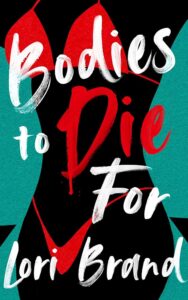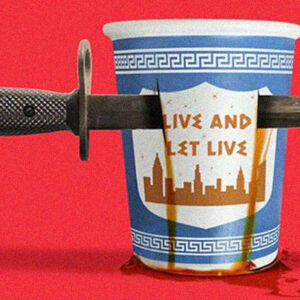In a world that wants us to shrink, what if we took up space? That’s the question at the heart of many of the recent thrillers that delve into body shaming.
It’s almost impossible to exist as a woman today without experiencing the persistent drip of Diet Culture. From well-meaning questions from loved ones (“should you really be eating that?”), to the cruel comments of online strangers (“she’s a fat pig”), to the villainization of whole food groups (carbs, fats, dairy, red meat), to the media’s obsession with celebrities’ bodies (Jessica Simpson, Lizzo, Adele). The message is clear: Be small. Be pliable.
What if you don’t feel like it?
Then you’ve likely got some latent rage frothing around inside of you.
The thing with rage is that it’s propulsive. It demands action. Ignoring it allows it to fester, potentially leading to anxiety, depression, or eating disorders. Unleashing it can be dicey. You might unload at the gym (good), tell an acquaintance to get bent (variable), or paint the world in bloody red (bad; don’t do this). Many of us could use some additional acceptable ways to process our emotions.
Enter the thriller. Thrillers are the perfect medium for exploring rage. They allow us access to a protagonist’s thoughts and motivations, ask unsettling questions, and feed our inner darkness. From the safety of our sofas, we watch as the characters’ lives unravel and wonder what they’ll do next. If we’d do the same thing. We’re along for the ride as their decisions drive the plot forward. Vicariously, we experience the cathartic release of their resolution.
In my thriller, Bodies to Die For, rage from body shaming is everywhere. It’s what kicks off the journey of the two protagonists, Gemma and Ashley. For Gemma, it’s the motivation to rid herself of Fat Gemma, her inner fat girl. For Ashley, it drives her to join a group of Fat Activists looking to take down Diet Culture by any means necessary. We also see it in the actions of the secondary characters. In how Ashley’s mom incessantly prods her to lose weight out of “concern for her health,” in a doctor’s ridiculous suggestion that Ashley’s size contributed to her injury from an SUV almost running her over, in Andrew wondering why Ashley would let herself get so fat (as if she owes him her attractiveness), in Kylie not wanting to hang around fat people because “they lower your brand.” Throughout the novel, the Diet Culture drips continue to build until they all become too much and everything explodes. Literally.
Back when I was writing Bodies to Die For, I thought that my background in dancing, gymnastics, and bodybuilding uniquely qualified me to write it. Now that it’s out in the world, I’ve been surprised by how many readers have told me their own Diet Culture horror stories (childhood fat camps, perpetually dieting mothers, boyfriends taking plates of food away). Thin or fat, young or old, we’ve all been touched by it.
Yet, it’s only been recently that rage from body shaming has made its way into fiction. Perhaps the book best known for heralding in this new era is Gillian Flynn’s Gone Girl. In this masterpiece, Amy has followed her husband, Nick, from her New York home to the middle of Missouri, allowed him invest the last of her trust fund in a bar, and watched as he began an affair with a younger woman.
Now she’s done. Done suppressing her emotions. Done making her needs small. Done being a Cool Girl.
The Cool Girl screed may be the best part of Gone Girl. It’s a rage-filled manifesto, where Amy explains that Cool Girls are a size 2 and above all hot. That they pretend to love threesomes and anal sex. That they are understanding and never get angry. Once Amy abandons being a Cool Girl, she is free to be herself. Someone who is smart, cunning, and ruthless.
Amy leaves Nick, framing him to look like he murdered her. But when she runs into trouble while on the run, she turns to a man she’s kept in the wings. Desi likes his women weak, thin, and small, and she allows him to see her that way. He takes her in, but doesn’t like her recent weight gain and rations out her food, trying to mold her into his vision of what she should be. He buys her things to control her. She becomes repulsed and disgusted by him and ends up slitting his throat post-coitus. #rageon
Building on Gone Girl’s fury, Sarai Walker delivered Dietland. In this delicious novel, the fat protagonist, Plum, is waiting for her real life–her thin life—to begin. Until then, she’s saving up for bariatric surgery and squireling away clothes for her new thinner self. All while a caloric metronome ticks in the background—green salad (150), Waist Watchers granola bar (90), black coffee (FREE FOOD)–and she avoids women who are loud, angry, and huge. Things she does not want to be.
Then she meets a girl in colorful tights and combat boots who introduces her to an underground society that has gone full-out guerilla warfare on those who harm women. Men literally fall from the sky. Bustle pronounced it, “Fight Club meets Margaret Atwood.” #Allthefeels
No ode to rage-filled thrillers would be complete without Laura Picklesimer’s Kill for Love. In this stunning debut, sorority girl Tiffany is thin, bored, and unfulfilled. Then one evening after a frat party she kills a man, eats a greasy chicken drumstick, and feels satisfied. And so begins her murderous rampage against the men who have objectified her. As she wreaks havoc on the world, she abandons eating carrot sticks and staying slim for gorging on red meat, lifting weights, and gaining muscle. Kill for Love explores sex, power, social media, and consumerism. It’s been likened to American Psycho, which is spot-on.
The book is a ride; the writing is gorgeous and includes such gems as: “She had gained ten pounds over the summer and had only three hundred followers on Instagram, so she wouldn’t exactly be missed.” “I could order Thai, eat it all in bed, and then rub one out and go to sleep.” “I fried bacon every morning and sirloin each night, shoved raw meat in the otherwise empty fridge, and didn’t bother putting on all my clothes most days. If this was the end of the world, bring it. I’d greet the apocalypse in lace lingerie.” #girlcrush
All these thrillers hit so hard because they tap into our inner rage. And that’s a good thing. Rage is sacred. It’s our intuition telling us that something’s not right. That we’re being taken advantage of or disrespected. Rage is not meant to be buried, but rather examined. It should drive action. Might I suggest starting by picking up one of these fabulous thrillers instead of a book of matches?
***


















